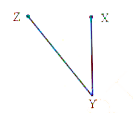Draw a pair of vertically opposite angles. Bisect each of the two angles. Verify that the bisecting rays are in the same line.
Step-by-Step Solution:
1. Draw the Vertically Opposite Angles:
- Start by drawing two intersecting lines that cross each other at a point. Label the intersection point as O.
- Label the points where the lines intersect as A, B, C, and D. This will create two pairs of vertically opposite angles: ∠AOB and ∠COD, as well as ∠AOD and ∠BOC.
2. Identify the Angles:
- You have now formed two pairs of vertically opposite angles:
- ∠AOB and ∠COD are vertically opposite.
- ∠AOD and ∠BOC are also vertically opposite.
- Note that vertically opposite angles are equal.
3. Bisect Angle AOB:
- To bisect angle AOB, take a compass and place the pointer on point O.
- Draw an arc that intersects both rays OA and OB. Label the intersection points as E and F.
4. Draw Arcs from Points E and F:
- Without changing the compass width, place the compass pointer on point E and draw an arc above the angle.
- Now, place the compass pointer on point F and draw another arc that intersects the first arc. Label the intersection of these arcs as G.
5. Draw the Bisector of Angle AOB:
- Using a ruler, draw a straight line from point O through point G. This line OG is the bisector of angle AOB.
6. Bisect Angle COD:
- Repeat the same process for angle COD. Place the compass pointer on point O and draw an arc that intersects rays OC and OD. Label the intersection points as H and I.
7. Draw Arcs from Points H and I:
- Without changing the compass width, place the compass pointer on point H and draw an arc above the angle.
- Now, place the compass pointer on point I and draw another arc that intersects the first arc. Label the intersection of these arcs as J.
8. Draw the Bisector of Angle COD:
- Using a ruler, draw a straight line from point O through point J. This line OJ is the bisector of angle COD.
9. Verify the Bisecting Rays:
- Observe that lines OG and OJ are in the same line. This confirms that the bisectors of angles AOB and COD are indeed in the same line.
- Start by drawing two intersecting lines that cross each other at a point. Label the intersection point as O.
- Label the points where the lines intersect as A, B, C, and D. This will create two pairs of vertically opposite angles: ∠AOB and ∠COD, as well as ∠AOD and ∠BOC.
- You have now formed two pairs of vertically opposite angles:
- ∠AOB and ∠COD are vertically opposite.
- ∠AOD and ∠BOC are also vertically opposite.
- Note that vertically opposite angles are equal.
- To bisect angle AOB, take a compass and place the pointer on point O.
- Draw an arc that intersects both rays OA and OB. Label the intersection points as E and F.
- Without changing the compass width, place the compass pointer on point E and draw an arc above the angle.
- Now, place the compass pointer on point F and draw another arc that intersects the first arc. Label the intersection of these arcs as G.
- Using a ruler, draw a straight line from point O through point G. This line OG is the bisector of angle AOB.
- Repeat the same process for angle COD. Place the compass pointer on point O and draw an arc that intersects rays OC and OD. Label the intersection points as H and I.
- Without changing the compass width, place the compass pointer on point H and draw an arc above the angle.
- Now, place the compass pointer on point I and draw another arc that intersects the first arc. Label the intersection of these arcs as J.
- Using a ruler, draw a straight line from point O through point J. This line OJ is the bisector of angle COD.
- Observe that lines OG and OJ are in the same line. This confirms that the bisectors of angles AOB and COD are indeed in the same line.
Topper's Solved these Questions
Similar Questions
Knowledge Check
- Question 1 - Select One
The diagonals of a rhombus bisect each other at _____ angles.
AAcuteBObtuseCRight.DStraight
Prove that the bisectors of a pair of vertically opposite angles are in the same straight line.
View SolutionFill in the blanks:(i) If two angles are complementary, then the sum of their measures is _______.(ii) If two angles are supplementary, then the sum of their measures is ______.(iii) Two angles forming a linear pair are _______________.(iv) If two adjacent angles are supplementary, they form a ___________.(v) If two lines intersect at a point, then the vertically opposite angles are always_____________.(vi) If two lines intersect at a point, and if one pair of vertically opposite angles areacute angles, then the other pair of vertically opposite angles are __________.
View SolutionBisect ∠XYZ
 View Solution
View SolutionIf diagonal of a quadrilateral bisects each other at right angles then it is a
View SolutionIf the bisector of the vertical angle of a triangle bisects the base of the triangle;then the triangle is isosceles.
View SolutionShow that the diagonals of a rhombus bisect each other at right angles.
View SolutionIn which quadrilateral diagonals bisect each other at right angles?
View Solution

